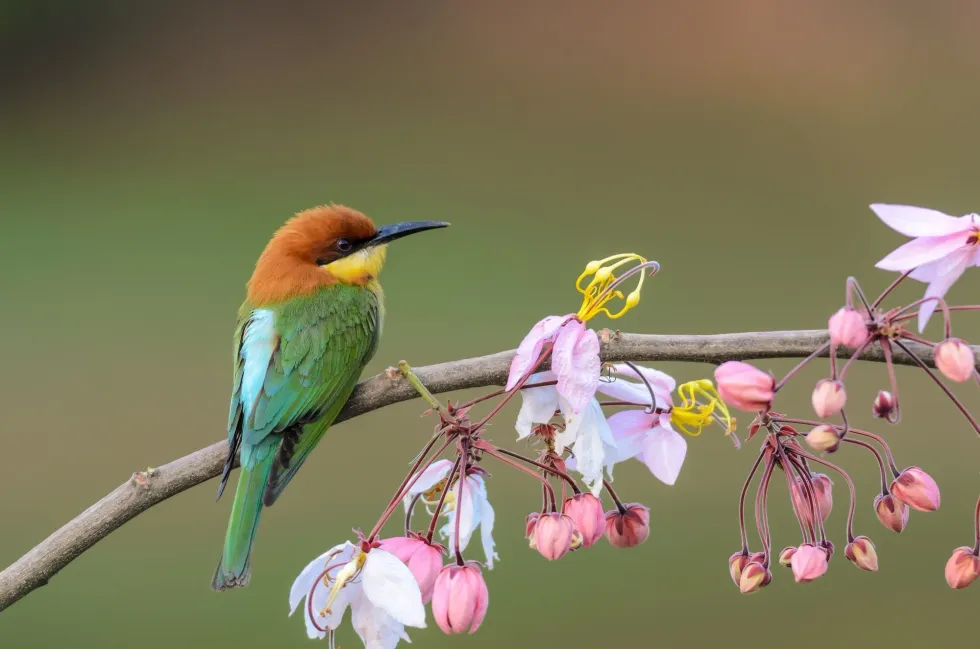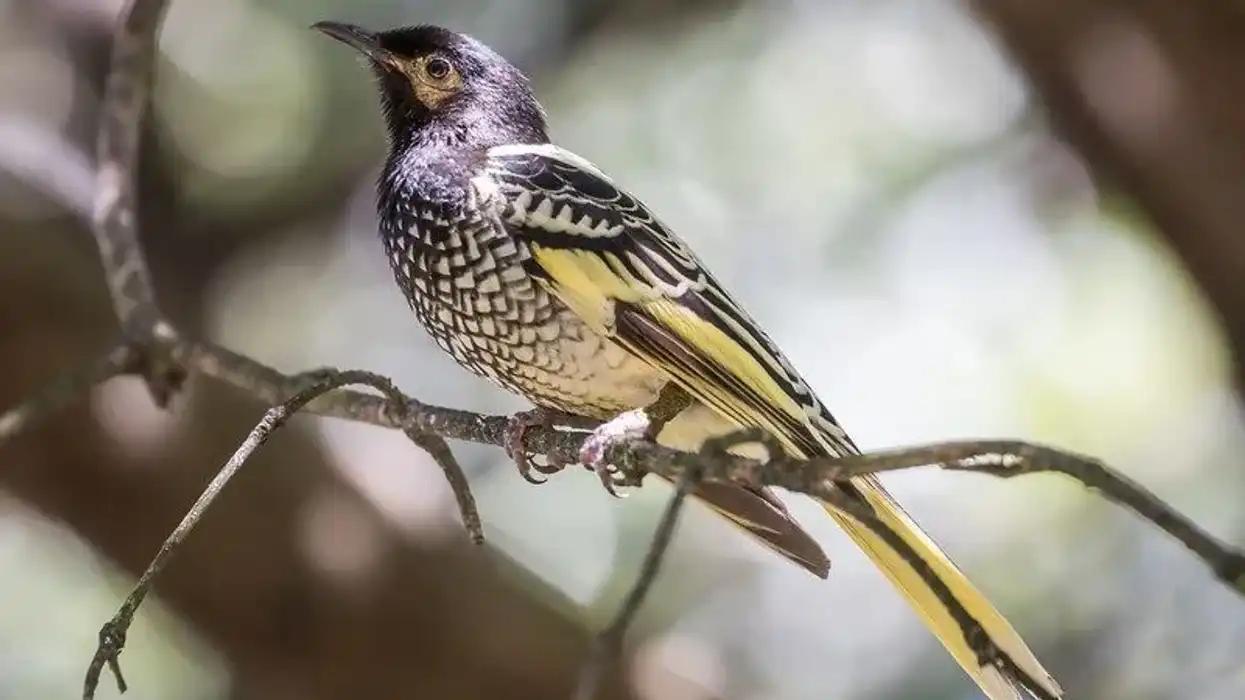The chestnut-headed bee-eater (Merops leschenaulti), also called the bay-headed bee-eater, is a bee-eater species of the family Meropidae. They lack two elongated central tail feathers possessed by almost all their relatives.
The Merops genus is a large genus of bee-eaters. Carl Limmeaus, a Swedish naturalist, introduced the genus in 1758 in his Systema Naturae, 10th edition.
The genus 'Merops' is an Ancient Greek term for 'bee-eater'. There are 27 species recognized in this genus. The Meropidae family consists of around 27 species within three genera.
This species predominantly feeds on insects, particularly wasps and bees. Constantine Samuel Rafinesque -Schmaltz, a French polymath, was the first to name this species under a scientific group in 1815.
However, the English term 'bee-eater' was used for the first time in 1668. Although ancestors of hooper, roller, and kingfisher families diverted from this species million years ago, these bee-eaters are still considered to be related to these families.
If you liked reading these interesting chestnut-headed bee-eater, then read some more vermilion flycatcher and belted kingfisher facts on Kidadl.
Chestnut-Headed Bee-Eater Interesting Facts
What type of animal is a chestnut-headed bee-eater?
The chestnut-headed bee-eater (Merops leschenaulti) is a bee-eater bird of the order Coraciiformes and phylum Chordata. This bird is gregarious and roosts and feeds in a community.
What class of animal does a chestnut-headed bee-eater belong to?
The chestnut-headed bee-eater (Merops leschenaulti) belongs to the class of Aves of animals.
How many chestnut-headed bee-eaters are there in the world?
The chestnut-headed bee-eater (Merops leschenaulti) population in the world is not known.
Where does a chestnut-headed bee-eater live?
Merops leschenaulti lives in the Indian subcontinent and adjoining regions, ranging from the east of India through to Southeast Asia.
What is a chestnut-headed bee-eater's habitat?
The range of chestnut-headed bee-eater's habitat includes sub-tropical, open woodlands regions that are close to water. This bird is also common in highlands.
Who do chestnut-headed bee-eaters live with?
Merops leschenaulti birds live in a community.
How long does a chestnut-headed bee-eater live?
The lifespan of Merops leschenaulti birds is not known. Their relatives, European bee-eaters, live for five to six years.
How do they reproduce?
The Merops leschenaulti species is gregarious and nest colonially in sandy banks. They create a comparatively long tunnel to fit five to six white eggs. These are around 10-100 nests in a colony.
They lay the eggs around February to June and the nests are also created on high cliffs. Both sexes incubate their eggs by rotating their turns. The chick fledges the nest in 30 days.
What is their conservation status?
The conservation status of Merops leschenaulti is evaluated as Least Concern. They are currently not threatened and their population is steady in their natural habitats.
Chestnut-Headed Bee-Eater Fun Facts
What do chestnut-headed bee-eaters look like?
The Merops leschenaulti species have a lower face, forehead, ear coverts, nape, and crown that are rich chestnut. The thin curved bill is black in color.
They are predominantly green with blue on their lower belly and rump. Their upper tail coverts and central tail feathers are blue with green on the tail's inner webs.
They have yellow on their throat, sides of the face, and chin, and a broad chestnut extends below this to the side of their neck and merges with the upper plumage colors.
Below this, there is a black and yellow band and the rest of the plumage feathers are green with blue tips, particularly under their tail coverts and their vents.
M. l. quinticolor, a Javan subspecies, can be distinguished by their pure yellow from their bill extending to the black pectoral band. Another subspecies found in the Andamans is slightly larger with dusky black legs, crimson iris, and dark horn claws.

How cute are they?
The Merops leschenaulti is a vibrantly colored bird and is considered cute.
How do they communicate?
These bee-eaters communicate using calls and body language. The chestnut-headed bee-eater call sounds like an airy 'chewy-chewy'. They repeatedly give out a soft bubbling 'pruik,' pruiip,' 'djewy,' or 'churit.' During the breeding seasons, these birds perform displays.
How big is a chestnut-headed bee-eater?
The Merops leschenaulti bird measures 7-7.8 in (18-20 cm) in length. Rainbow bee-eaters are 9.1-11 in (23.1-27.9 cm), measuring almost 2 in (5 cm) more than chestnut-headed bee-eaters.
How fast can a chestnut-headed bee-eater fly?
The Merops leschenaulti bird has butterfly-like flight, gliding with their wings held high over their back. Their flight speed is not known.
How much does a chestnut-headed bee-eater weigh?
The Merops leschenaulti bird weighs around 0.05-0.072 lb (23-33 g).
What are the male and female names of the species?
There is no particular name given to male and female bee-eaters.
What would you call a baby chestnut-headed bee-eater?
There is no particular name given baby chestnut-headed bee-eaters. Young birds are usually referred to as chicks.
What do they eat?
As the name suggests, bee-eaters predominantly eat insects particularly bees, hornets, and wasps. They also feed on dragonflies, termites, ants, grasshoppers, and butterflies.
Are they dangerous?
No, they pose no danger to human beings.
Would they make a good pet?
No, these birds are a wild species and would not make good pets.
Did you know...
Ancient writers like Virgil and Aristotle mentioned this species, advising beekeepers to kill these birds. In Greek mythology, Theban Botres was struck badly by his father for disrespecting a sacrifice and it is said that the God turned him into a bee-eater after taking pity on him.
These birds may hunt together in a group by wheeling flight and catch insects one after another without returning to the perch.
It was believed by ancient Egyptians that bee-eaters possessed medicinal properties. In Hinduism, the shape formed when these birds fly was thought to resemble a bow along with their longbows resembling an arrow. This resemblance gave them a Sanskrit name that translates to 'Vishnu's bow', referring to the 'archer God'.
How did the chestnut-headed bee-eater get its name?
The chestnut-headed is named due to their chestnut-colored head. The common scientific name, 'Merops' translates to 'bee-eaters'. The specific scientific name 'Leschenaulti' honors Jean Baptiste Leschenault de la Tour, a French ornithologist and botanist.
What are the different types of bee-eaters and how are they different?
Little bee-eaters (Merops pusillus) are brightly colored with green upperparts, black gorgets, rick brown upper breast that fades into buff-ochre on the belly, and yellow throats. Purple bearded bee-eaters (Meropogon forsteni) have green upper parts, tails, and wings with purple faces, bead or throat feathers, head, and breast.
The upper belly varies between purple and reddish-brown colors in males and females. This bird is the only bird in this genus.
Red-bearded bee-eaters (Nyctyornis amictus) are green with a red face and orange eyes. Blue-bearded bee-eaters of the genus, Nyctyornis, are small grass green colored with the turquoise chin, face, and forehead.
European bee-eaters (Merops apiaster) have yellow and brown upper parts with green wings and black beaks. There are a total of 27 species in the Merops genus like green bee-eaters, black bee-eaters, Somali bee-eaters, and 0live bee-eaters.
Here at Kidadl, we have carefully created lots of interesting family-friendly animal facts for everyone to discover! For more relatable content, check out these secretary bird facts and click beetle facts for kids.
You can even occupy yourself at home by coloring on one of our free printable chestnut headed bee eater coloring pages.









